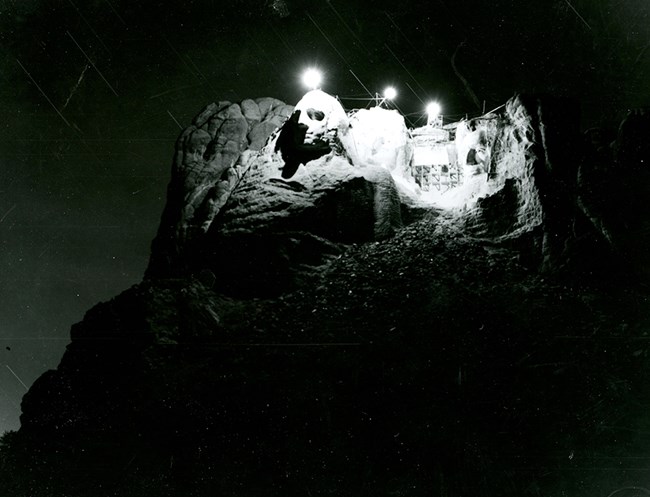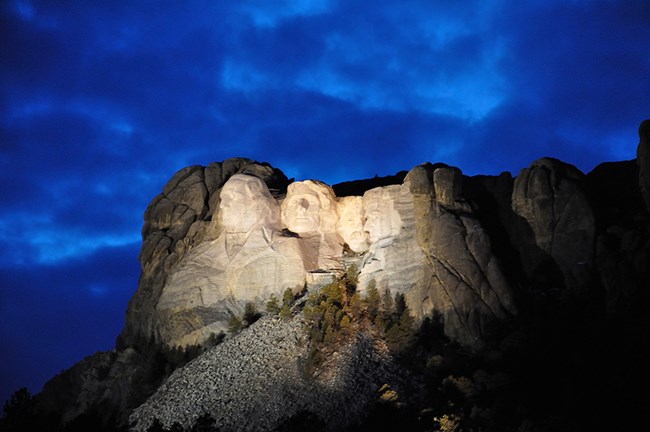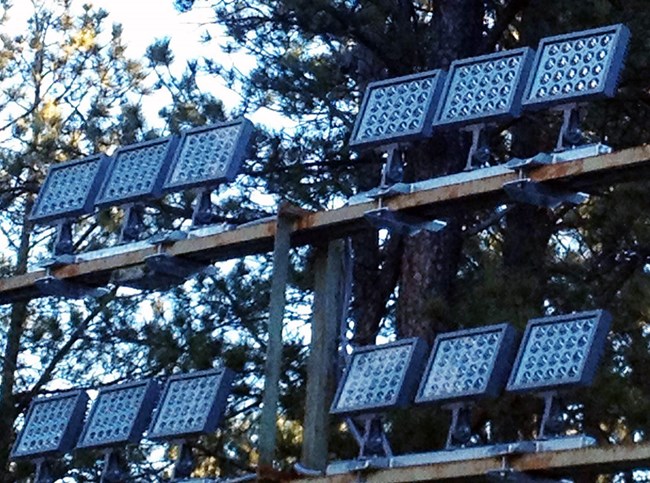
Sculptor Gutzon Borglum was very concerned with the effects of light on the memorial. He spent hours studying the different shadows produced by the sun and made many adjustments to achieve the best viewing during daylight hours. 
NPS During the week of May 16 - 23 three giant army searchlights lit the memorial from a distance of three to four miles away. These lights were stationed at the first pigtail bridge on the Iron Mountain Road, on Iron Mountain itself and in Keystone. In order to maintain a communication link between all the lights State Patrol cars were positioned by each light and at the memorial headquarters. The combined power of all three lights equaled one billion candle power. The lighting was successful and they were turned on May 16 and remained on during the whole week for the celebration. The lighting success led to a brainstorming effort to find a more permanent solution. In December, 1948, Superintendent Suter and three engineers from the National Park Service regional office in Omaha, Nebraska, met with the Black Hills Power and Light Company to discuss a plan to light the memorial. By August, 1949, Black Hills Power and Light had completed installation of a power line from Keystone to Mount Rushmore and began constructing power distribution boxes. The power system was finished and tested by November, 1949. The lighting was a little disappointing as there were many unwanted shadows and not enough shadows for contrast at other points. Many at the time hoped the lighting would improve when all the lights were properly focused. Two banks of lights, each containing 27 Crouse-Hinds and Westinghouse searchlights were located southeast of the memorial on Doane Mountain near the concession building. Each of the 54 searchlights were rated at 1,500 watts and produced a combined total of 81,000 watts, after all the focusing was completed in December, it was determined that additional lights were needed. The following April, a study determined that two more searchlights were needed to improve the lighting of the memorial. The efforts were partly successful, but again it was determined that an additional bank of eight to ten lights was needed. Adjustments to searchlights and the previously installed lights continued throughout the summer of 1950 and on June 25th a ceremony was held dedicating the new lighting system. Nearly 5,000 people attended the ceremony, which featured an address by columnist Drew Pearson. Shortly thereafter, from August 1 through Labor Day, lighting programs were held on a regular schedule from 8:00 p.m. to 10:00 p.m. By mid February of 1951, the additional light bank was completed and tested. This third bank of lights consisted of eight searchlights (1,000 watts each) and was located to the east of the memorial. The three banks of lights now totaled 62 lights and equaled 89,000 watts. 
NPS As technology progressed the lighting system was upgraded in 1990 and then again in 1998. The 1998 upgrade consisted of 32 metal halide and high pressure sodium lights equaling 18,800 watts. Most recently, in December, 2014, the memorial switched to a LED (light emitting diode) light system. This new system was donated by Musco Lighting from Oskaloosa, Iowa. Experts in sports venue lighting systems, Musco worked with staff from Mount Rushmore throughout 2014 to design, develop and install the newest and most energy efficient system ever used at the memorial. The new system consists of 1,600 individually focused LEDs that use only 2.34 kilowatts per hour, which is less than ten percent of the electricity consumed by the lights used since 1998. |
Last updated: January 29, 2023
